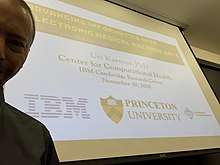MELD-Plus
MELD-Plus is a risk score to assess severity of chronic liver disease. The score includes nine variables as effective predictors for 90-day mortality after a discharge from a cirrhosis-related admission. The variables include all Model for End-Stage Liver Disease (MELD)'s components, as well as sodium, albumin, total cholesterol, white blood cell count, age, and length of stay. MELD-Plus was created as a result of a collaboration between Massachusetts General Hospital and IBM.[1]

| MELD-Plus | |
|---|---|
| Medical diagnostics | |
| Purpose | Assess severity of chronic liver disease |
The development of MELD-Plus was based on using unbiased approach toward discovery of biomarkers. In this approach, a feature selection machine learning algorithm observes a large collection of health records and identifies a small set of variables that could serve as the most efficient predictors for a given medical outcome. An example for a notable feature selection method is lasso (least absolute shrinkage and selection operator).[2]
Because total cholesterol and hospital length of stay are typically not uniform factors across different hospitals and may vary in different countries, an additional model that included only 7 of the 9 variables was evaluated. This yielded a performance close to the one of using all 9 variables and resulted in the following associations with increased mortality: INR, creatinine, total bilirubin, sodium, WBC, albumin, and age.
Calculators
A calculator capable of comparing MELD, MELD-Na, and MELD-Plus is available.[3]
Calculators capable of calculating MELD and MELD-Na are available.[4][5][6][7]
Press coverage
Johnson HR. Developing a new score: how machine learning improves risk prediction.[8]
Livernois C. Harvard researchers develop predictive model for cirrhosis outcomes.[9]
Goedert J. IBM taps machine learning to predict cirrhosis mortality rates.[10]
Cohen JK. Harvard, IBM researchers develop prediction model for cirrhosis outcomes.[11]
Massachusetts General Hospital (Snapshot of Science).[12]
External validation
A call for an additional validation of MELD-Plus was published in November 2019 in the European Journal of Gastroenterology & Hepatology.[13]
A study presented in June 2019 in Semana Digestiva[14] (Vilamoura, Portugal) demonstrated that MELD-Plus was superior to assess mortality at 180 days vs. other liver-related scores in a population admitted due to hepatic encephalopathy.[15]
A study published in April 2018 in Surgery, Gastroenterology and Oncology reported on the increased accuracy of using MELD-Plus vs. MELD in predicting early acute kidney injury after liver transplantation.[16]
MELD-Plus was validated by using Explorys.[17]
Potential of alternative scores to extend life expectancy
United Network for Organ Sharing proposed that MELD-Na score (an extension of MELD) may better rank candidates based on their risk of pre-transplant mortality and is projected to save 50-60 lives total per year.[18] Furthermore, a study published in the New England Journal of Medicine in 2008, estimated that using MELD-Na instead of MELD would save 90 lives for the period from 2005 to 2006.[19] In his viewpoint published in June 2018, co-creator of MELD-Plus, Uri Kartoun, suggested that " ...MELD-Plus, if incorporated into hospital systems, could save hundreds of patients every year in the United States alone."[20]
A review specifying alternatives to MELD, including MELD-Na, MELD-sarcopenia, UKELD, D-MELD, iMELD, and MELD-Plus, was published on June 2019 in Seminars in Liver Disease.[21]
Criticism of machine learning in prediction modeling
Chen & Asch 2017 wrote: "With machine learning situated at the peak of inflated expectations, we can soften a subsequent crash into a “trough of disillusionment” by fostering a stronger appreciation of the technology’s capabilities and limitations." However, the authors further added "Although predictive algorithms cannot eliminate medical uncertainty, they already improve allocation of scarce health care resources, helping to avert hospitalization for patients with low-risk pulmonary embolisms (PESI) and fairly prioritizing patients for liver transplantation by means of MELD scores."[22]
Source code
A sample code for calculating MELD-Plus is available in GitHub.[23]
References
- Kartoun, Uri; Corey, Kathleen E; Simon, Tracey G; Zheng, Hui; Aggarwal, Rahul; Ng, Kenney; Shaw, Stanley Y (2017). "The MELD-Plus: A generalizable prediction risk score in cirrhosis". PLoS ONE. 12 (10): e0186301. Bibcode:2017PLoSO..1286301K. doi:10.1371/journal.pone.0186301. PMC 5656314. PMID 29069090.
- Zou H. The adaptive lasso and its oracle properties. Journal of the American Statistical Association. Volume 101, 2006 - Issue 476. 2006.
- https://github.com/kartoun/meld-plus/raw/master/MELD_Plus_Calculator.xlsx
- https://www.mdcalc.com/meld-score-model-end-stage-liver-disease-12-older
- https://optn.transplant.hrsa.gov/resources/allocation-calculators/meld-calculator/
- https://reference.medscape.com/calculator/meld-score-end-stage-liver-disease
- http://gihep.com/calculators/hepatology/meld-na/
- "Developing a New Score: How Machine Learning Improves Risk Prediction". 2017-11-17.
- "Harvard researchers develop predictive model for cirrhosis outcomes".
- "IBM taps machine learning to predict cirrhosis mortality rates".
- "Harvard, IBM researchers develop prediction model for cirrhosis outcomes".
- "Snapshot of Science for October 2017 - Massachusetts General Hospital, Boston, MA".
- https://journals.lww.com/eurojgh/Citation/2019/12000/MELD_plus__a_call_for_an_additional_external.22.aspx
- http://www.semanadigestiva.pt/
- https://figshare.com/articles/O_PAPEL_DOS_SCORES_DE_BABS_E_MELD-PLUS_EM_DOENTES_COM_ENCEFALOPATIA_HEP_TICA/11324060
- Marian-Irinel, Marian-Tudoroiu; Constantin, Georgiana; Pâslaru, Liliana; Iacob, Speranţa; Gheorghe, Cristian; Popescu, Irinel; Tomescu, Dana; Simona Gheorghe, Liliana (2018). "The Combination of Serum Cystatin C, Urinary Kidney Injury Molecule-1 and MELD plus Score Predicts Early Acute Kidney Injury after Liver Transplantation". Surgery, Gastroenterology and Oncology. 23 (2): 121–126. doi:10.21614/sgo-23-2-121.
- https://www.ibm.com/downloads/cas/RPKNLL1M
- "Meeting agenda" (PDF). optn.transplant.hrsa.gov. 2014.
- Kim, WR; Biggins, SW; Kremers, WK; Wiesner, RH; Kamath, PS; Benson, JT; Edwards, E; Therneau, TM (2008). "Hyponatremia and mortality among patients on the liver-transplant waiting list". N Engl J Med. 359 (10): 1018–6. doi:10.1056/NEJMoa0801209. PMC 4374557. PMID 18768945.
- Kartoun, Uri (2018). "Toward an accelerated adoption of data-driven findings in medicine". Medicine, Health Care and Philosophy. 22 (1): 153–157. doi:10.1007/s11019-018-9845-y. PMID 29882052.
- Sacleux, Sophie-Caroline; Samuel, Didier (26 June 2019). "A Critical Review of MELD as a Reliable Tool for Transplant Prioritization". Seminars in Liver Disease. 39 (4): 403–413. doi:10.1055/s-0039-1688750. PMID 31242526.
- Chen, Jonathan H; Asch, Steven M (2017). "Machine Learning and Prediction in Medicine — Beyond the Peak of Inflated Expectations". New England Journal of Medicine. 376 (26): 2507–2509. doi:10.1056/NEJMp1702071. PMC 5953825. PMID 28657867.
- "kartoun/meld-plus". GitHub. 2018-01-07.